Chip Repair on a Pressed Steel Bath
Chip Repairs
Of all the repair work we do on Baths, sinks and the like, the most common is repairing a chip or chips on pressed steel baths. Pressed steel baths have many advantages over cast iron. They are lighter, cheaper and easier to install. They also have advantages over most acrylic baths. They are longer lasting generally. There is less flexing and movement of the bath when in use so problems such as putting your knee through the bath or cracks appearing, as sometimes occurs with acrylic baths, does not occur with a pressed steel bath.
But a major dis-advantage of pressed steel is the fact of the enamel being very hard and brittle. So much so that when there is an impact on the surface of the bath, the enamel can’t flex or absorb the impact and often a chip of enamel is knocked of the surface of the bath. Often (in fact usually in my experience) the chip exposes the metal below the enamel. As the metal is treated and black, it really shows up against the enamel.
Here is a picture of a chip on a pressed-steel bath. This was a repair done in a home near Rochester:
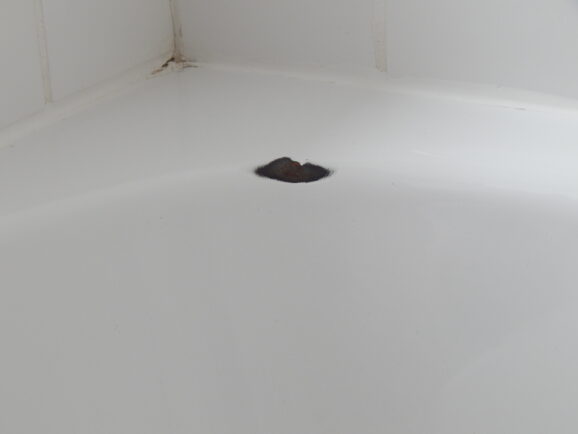
Chip on a pressed steel bath
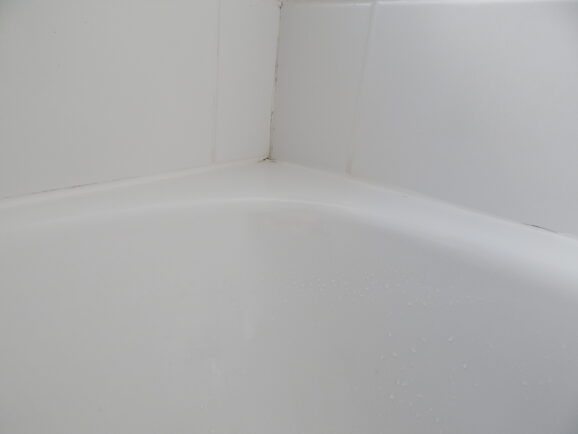
The first issue with a chip is cosmetic. It just looks wrong in a bath and does tend to catch the eye. The second issue is that left long enough, rust can start to form. And that, left long enough, can work its way though the steel of the bath and you can end up with a hole.
The good news is that it does tend to take a long time for this to happen, especially on higher end pressed-steel baths which tend to use a thicker steel in the construction of their baths. But it is best to repair the chip. as soon as possible.
So a repair of a chip on a pressed steel bath serves two purposes: the first is cosmetic and takes the eye of the damages area. The second is that the repair keep the water from being in direct contact with the steel and so prevents rusting or corroding of the metal below.

The chip in this pressed steel bath has “disappeared”
It would seem that for most people, the primary reason to get a chip repair done is cosmetic. We can certainly rectify this.
The level of repair we go for is that if someone was to walk into the room after we have done the work, they wouldn’t see the repaired area, their eye wouldn’t be drawn to it and catch on it. Often however, we can get it to the point where the customer themselves cannot see the repair or locate where the original chip was located.
The secret to getting an invisible repair, or very close to invisible, is that we make the colour onsite to match the item we are repairing. We don’t use a selection of several shades of white (most repairs, especially of pressed steel, are some shade of white) and go with the closest. What we do is we actually build the colour onsite to match the specific item we are repairing. It can be a lot of work trying to match a colour onsite, especially if the lighting in the room isn’t great and it adds a lot of time to the process but it’s the best way we have found to make repair as good and as invisible as possible
Acrylic Bath Chip Repair
- At June 21, 2012
- By
- In repair an acrylic bath / Repair bath
Acrylic bath chip repair. A repair using acrylic coating.
We were called to repair this damaged area on an acrylic bath (these are often referred to as “plastic baths”).
The client’s radiator had fallen off the wall and damaged the top edge of the bath.
Unfortunately the damaged area was below a skylight and on the side of the bath closest to the door, so it was highly visible and a repair would have to be exceptionally good for it not to catch the eye or be felt as one got in and out the bath.
There is a technique we have been using on spa baths where the final step has been to apply an acrylic coating over the repaired area. The coating is mechanically blended into the existing acrylic shell of spa bath with the result that the repair cannot be felt or seen.
Here you can see the damaged bath
This is not something we normally do when doing repairs on baths as it doubles the time taken to carry out the repair to around 4 hours, and in many situations the extra cost incurred is not warranted.
But for this bathroom, where the rest of the room was in pristine condition and where the damage was in a very visible spot, we thought it would be worth applying the acrylic coat and blending it to the bath.
The video of the repair is very jerky I’m afraid, but it does give an idea of the finished work.
This technique is only suitable for Acrylic and Fibreglass baths which have a gel coat. It would not work on cast iron or pressed steel baths.
If you would like to see how the repair looked at the end have a look at our video entitled “Acrylic Bath Repair”.
Bath Repairs, Chip Repairs and Cracks in a Bath
The Bath Business delivers a bath repair service for baths that have chips, scratches, cracks, scuffs, dings etc on the bath’s surface.
There are many instances where a bath in otherwise good condition has had its surface chipped or damaged. In such cases a bath repair is a definite option. Rather than resurface the whole bath, which is our mainline service, we would do a localised bath repair to the damaged area only.
If the bath has numerous chips however or the bath repair would need to be done over an extensive area we may well recommend resurfacing rather than attempting to do a bath repair over a large area of damage. Also, when repairing a bath the repair work works best on new baths that have been damaged. If your bath is 20 years old it may well be worth getting the bath resurfaced whilst having any damaged repaired at the same time.
 Also if the bath is in a dull or worn condition and also has a chip or two we may recommend resurfacing as opposed to doing a chip or bath repair. Bath resurfacing encompasses repairing any chips. The reason we would recommend resurfacing in an older, worn bath rather than a bath repair or chip repair is because at the time of the repair the bath repair would be done to match the bath. If the bath is worn the worn areas will continue to attract dirt and gradually look worse. The bath repair will not attract dirt so eventually there will be a discrepancy and you will be able to see where the repair was done. A bath repair or chip repair works best on a relatively new bath.Try and tell us as much as you can about the bath when you inquire so we can recommend the correct course of action.
Also if the bath is in a dull or worn condition and also has a chip or two we may recommend resurfacing as opposed to doing a chip or bath repair. Bath resurfacing encompasses repairing any chips. The reason we would recommend resurfacing in an older, worn bath rather than a bath repair or chip repair is because at the time of the repair the bath repair would be done to match the bath. If the bath is worn the worn areas will continue to attract dirt and gradually look worse. The bath repair will not attract dirt so eventually there will be a discrepancy and you will be able to see where the repair was done. A bath repair or chip repair works best on a relatively new bath.Try and tell us as much as you can about the bath when you inquire so we can recommend the correct course of action.
If you are a contractor & you are trying to have a bath repaired before a client sees it let us know. We make the repair as invisible as is possible as you look face onto the repair. But it will never be completely invisible from all angles. For example, if you painted half a wall exactly the same colour as the wall had already been painted 6 months earlier you would be able to see the edge if you looked for it. Similarly with a chip repair. If you keep looking for the repaired area you will eventually find an edge. If you are a contractor and it is important that the repair is not visible from any angle we would recommend you have the whole bath resurfaced. Any chips, dings or scratches will be rectified with the bath being completely resurfaced.
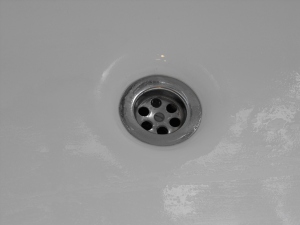 The type of repairs that can be done are chips to the enamel of cast-iron and pressed steel baths, scratches on enamel baths and pressed steel baths. Dents or dings to plastic or acrylic baths as well as scratches, cracks and also small holes punched through the surface of plastic or acrylic baths.
The type of repairs that can be done are chips to the enamel of cast-iron and pressed steel baths, scratches on enamel baths and pressed steel baths. Dents or dings to plastic or acrylic baths as well as scratches, cracks and also small holes punched through the surface of plastic or acrylic baths.
The procedure for doing a Bath Repair is to fill the chipped or dinged area and sand smooth.
Next, the material which is to be sprayed over the filled area is colour matched to the existing surface of the bath. We do the colour matching on site.This is the most important part of a Bath Repair and this procedure does require a lot of skill and experience.
Even if the existing surface is white, there are many, many shades of white. If the colour isn’t matched then the repaired area will stand out and catch the eye. A badly colour matched repair can look like someone has been in with a jar of tipex. If you have tried to repair a chip or ding yourself you’ll already have observed this.
Another difficulty can be the lighting. In one bathroom the lighting was such that although the tiles on the floor were exactly the same as the tiles on the walls, the tiles on the walls looked considerably darker. So a repair in this bathroom had to be carried out with a lot of expertise to get the exact colour match.
Once the colour is matched then the filled area is airbrushed over. The area may then be polished if any dust has landed on the wet material.
The procedure for a bath repair can also be applied to shower trays, wash hand basins and well also toilets.
Repairing cracks in an acrylic bath requires a completely different procedure. A successful repair to a crack is often dependant upon gaining access to the underside of the bath or cracked item.
It is best to contact The Bath Business directly for advice on how to repair your bath.
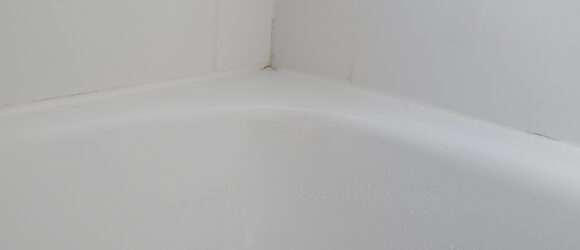

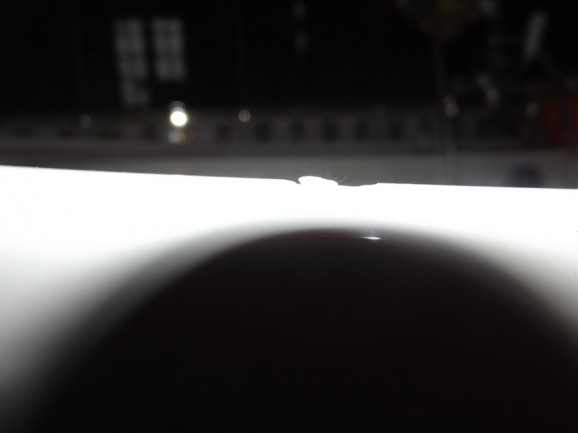

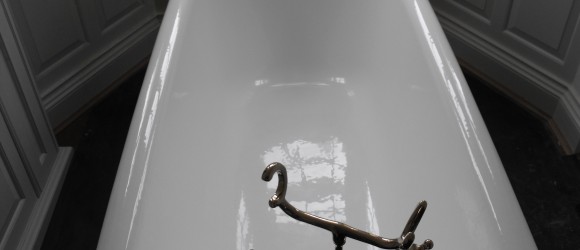



 Add us to your circle
Add us to your circle